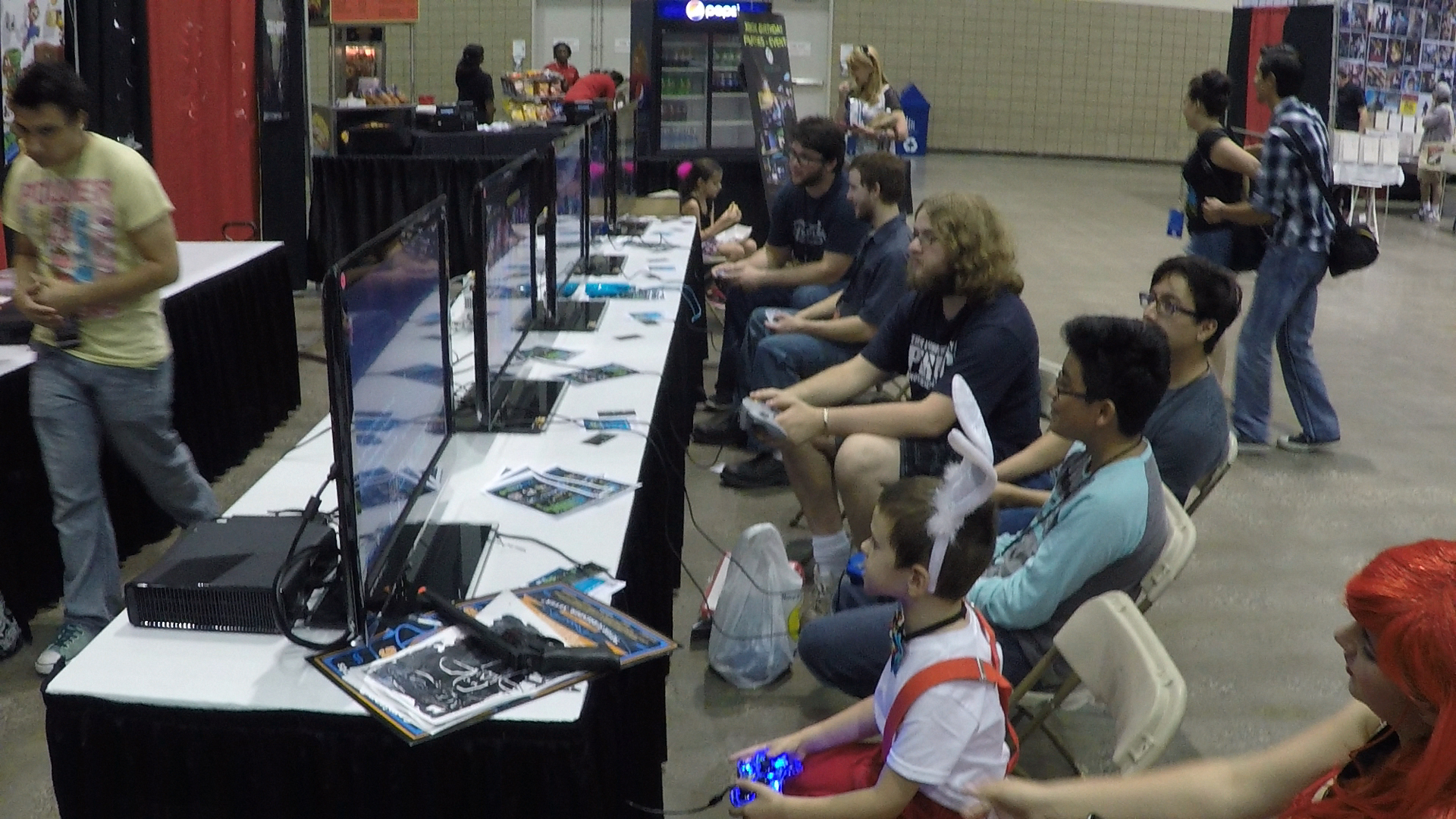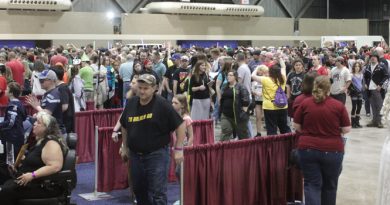Gaming at Kansas City Comic Con

Comic Cons, by and large, are purely print and video entertainment entities. Oddly enough, there was a bit of a gaming presence at this year’s Kansas City Comic Con.
First off: There were three dedicated gaming booths on the main dealer floor. There were representatives from the Tapcade, a local arcade themed bar and grill, who had a small little arcade set-up (comprised of about 4 old-school arcade cabinets) to let convention attendees play classic titles such as Mario Bros and Galaga. There was a large booth set up by a traveling video gaming rental company letting attendees play more modern titles such as Minecraft. And the other major booth was a home-brew pen and paper company selling their Kickstarter Acclaimed pen and paper RPG, Numenera and The Strange. There was also a small “game store” booth set up, but it was just simply a subset of a larger comic book store vendor.
Unlike other conventions in Kansas City that I have attended over this summer, Kansas City Comic Con didn’t have a room dedicated to video gaming. Though at this other convention, the room was part of a traveling 3rd party company that sets up these sorts of video gaming rooms and focus on games with lots of competition such as DOTA2 and Smite.
However, at Kansas City Comic Con, there was a board game room (which is rather standard for most conventions by now), and there was also a gaming convention staple, a pen and paper RPG room. While the time I was in that room was brief, I saw that it was mostly empty save for a several tables of players adamantly storming through dungeons, drinking in taverns, and taking on a star cruiser or two.
The two rooms, board games and RPG, were also linked side by side and only separated by a partially closed wall that gave both sides privacy from the other but also let wandering gamers float between the two rooms. As much as I would have liked to sit down, roll some dice, and play with some of these teams, I didn’t quite have the four to six hours to spare that pen and paper requires. What was good to see was that one of the gaming panelists, Sterling Hershey, was running a game with the Star Wars RPG that he had written content for. Whether or not the other panelist I met ran games, I wasn’t around long enough to see, but I was only in the gaming rooms for a brief time.
The Panel
A quick note on panels. Kansas City Comic Con did itself a large disservice when it came to panels. Under the guise of “going paperless” to avoid wasting paper by printing out con books and guides for all attendees, they failed pretty spectacularly at moving guests to places and events like panels. To find out when a panel was, you had to go to their website and look at “Panels” under the events tab. That would tell you the time, tentative room number, and title of every single panel for all days.
In theory that’s pretty OK, but in practice, when you have hundreds of people trying to look at the website at once, several panels going on at the same time, the fact that you have to stop everything you are doing to navigate their website, room numbers written on chalkboards with extremely faint and impossible to see further than 5 feet away chalk (in the future it would be better to use sidewalk chalk), no wi-fi for devices without a cell network, and my biggest complaint, no calendar block layout (a simple PDF time chart). It was a mess and it resulted in some pretty poor panel turnouts.
The panels, however, trudged on despite turnout. One of these panels, early on after the con’s opening, was the Breaking Into Gaming panel with Sterling Hershy, who has written for the popular Star Wars RPG as well as a few stories for Dungeons and Dragons, and sadly enough the other guest at the panel isn’t listed on the Kansas City Comic Con website and whose name was not picked up by my limited film equipment’s audio, but the gentleman had worked a great deal on the Call of Cthulhu pen and paper RPG.
The panel was about how to “break in” to the world of writing for pen and paper RPGs. Much of the information was aligned with what I am learning in school for video game design. The first step is to write and to write a lot. The second is to get your writing out there. The panelists stressed about submitting your works to contests and open calls and using blank RPGs, like Savage Worlds, to create your own works then submit it to those companies when those companies host a contest, sweepstakes, or open call for works. Look at self publishing and Kickstarter when you start having a following of readers/players. That sort of thing.
It is very much along the lines of “If you want to design games, first you have to design games”. Most of the panel was comprised of places to try and get published or noticed, but the take-away was mostly boiled down to: “Write a lot, find what you are passionate about, find companies that are hosting contest or submissions for that content, and then submit your works”.
The other important lesson was that writing doesn’t pay well. It never really does for anyone. Both of the panelists had full time jobs and then wrote for their respective RPG companies on the side as a hobby. Money isn’t why you would do this, as most places only pay a few cents a word if you’re lucky to even be paid; it’s mostly done for the love of the game and creating content for players.
The panelists were very knowledgeable about the publishing field as both have had the standard trials and tribulations of getting works out through publishing companies. They talked briefly on what someone would have to do to be published and the ups and downs of the newer self publishing options. The difference turned out to be “audience”. If you have enough of a following to get people excited about your works, then self publishing through something like Kickstarter is a good option. However, if you are not very well known, you can start by taking your content to places like gaming conventions such as Gen con to show off to the various publishing sponsors at those conventions.
One of the things that I hadn’t thought much about that the panel discussed was formatting. Specifically how a pen and paper RPG company commissions a writer. I knew the obvious transaction between a company and a writer, where a company would have a theme that they would give to the writer to write about, but what I didn’t know is that some companies would have it boiled down to the exact word count or page number. Or that the rules for the game and the story of the game are written as separate entities. Writing with such constraints would be a pretty difficult task to complete on a tight deadline, for sure. However, you can practice that sort of writing constraints with some of the writing contests for RPG writing, such as One Page Dungeon, that was mentioned in the panel. Another good but more generally open contest is by the makers of Pathfinder, Pazio, with RPG Superstar contest.
In all, the panel was more “where to go to get started” that it was about any specific topic in the realm of game writing. And that wasn’t bad at all. It was pretty fitting for the limited number of people that showed up.
![]()



